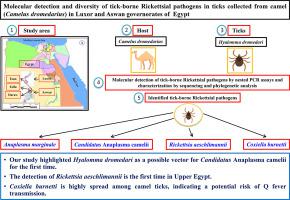当前位置:
X-MOL 学术
›
Acta Trop.
›
论文详情
Our official English website, www.x-mol.net, welcomes your
feedback! (Note: you will need to create a separate account there.)
Molecular detection and diversity of tick-borne rickettsial pathogens in ticks collected from camel (Camelus dromedarius) in Upper Egypt
Acta Tropica ( IF 2.1 ) Pub Date : 2024-03-05 , DOI: 10.1016/j.actatropica.2024.107172
Ahmed M Soliman 1 , Hassan Y A H Mahmoud 2 , Moaz M Amer 3 , Tatsuro Hifumi 4 , Tetsuya Tanaka 5
Acta Tropica ( IF 2.1 ) Pub Date : 2024-03-05 , DOI: 10.1016/j.actatropica.2024.107172
Ahmed M Soliman 1 , Hassan Y A H Mahmoud 2 , Moaz M Amer 3 , Tatsuro Hifumi 4 , Tetsuya Tanaka 5
Affiliation

|
Tick-borne rickettsial pathogens pose significant threats to public and animal health. In Upper Egypt, limited information exists regarding the prevalence and diversity of such tick-borne pathogens. Therefore, this study aimed to conduct a comprehensive investigation to elucidate the presence and variety of tick-borne rickettsial pathogens in Upper Egyptian camels. Our results revealed a prevalence of 2.96 % for and 0.34 % for Anaplasma camelii among ticks. However, spp. weren't detected in our study. The identification of A. camelii in ticks was documented for the first time, suggesting a potential mode of transmission in camels. Notably, this study marks the first documentation of with a prevalence of 6.06 % in the study area. Furthermore, we detected in a prevalence of 8.08 % in ticks, indicating a potential risk of Q fever transmission. Molecular techniques results were confirmed by sequencing and phylogenetic analysis and provided valuable insights into the epidemiology of these pathogens, revealing their diversity. This study is vital in understanding tick-borne rickettsial pathogens' prevalence, distribution, and transmission dynamics in Upper Egypt. In conclusion, our findings emphasize the importance of continued research to enhance our understanding of the epidemiology and impact of these pathogens on both animal and human populations.
中文翻译:

上埃及骆驼蜱中蜱传立克次体病原体的分子检测和多样性
蜱传立克次体病原体对公众和动物健康构成重大威胁。在上埃及,有关此类蜱传病原体的流行率和多样性的信息有限。因此,本研究旨在进行全面调查,以阐明上埃及骆驼中蜱传立克次体病原体的存在和种类。我们的结果显示,蜱虫中骆驼无形体的患病率为 2.96%,骆驼无形体的患病率为 0.34%。然而,spp。我们的研究中没有检测到。首次在蜱中鉴定出骆驼毛蜱,这表明骆驼中存在潜在的传播模式。值得注意的是,这项研究首次记录了该研究区域的患病率为 6.06%。此外,我们检测到蜱虫的患病率为 8.08%,表明存在 Q 热传播的潜在风险。分子技术结果通过测序和系统发育分析得到证实,并为这些病原体的流行病学提供了宝贵的见解,揭示了它们的多样性。这项研究对于了解上埃及地区蜱传立克次体病原体的流行、分布和传播动态至关重要。总之,我们的研究结果强调了继续研究的重要性,以增强我们对流行病学以及这些病原体对动物和人类影响的了解。
更新日期:2024-03-05
中文翻译:

上埃及骆驼蜱中蜱传立克次体病原体的分子检测和多样性
蜱传立克次体病原体对公众和动物健康构成重大威胁。在上埃及,有关此类蜱传病原体的流行率和多样性的信息有限。因此,本研究旨在进行全面调查,以阐明上埃及骆驼中蜱传立克次体病原体的存在和种类。我们的结果显示,蜱虫中骆驼无形体的患病率为 2.96%,骆驼无形体的患病率为 0.34%。然而,spp。我们的研究中没有检测到。首次在蜱中鉴定出骆驼毛蜱,这表明骆驼中存在潜在的传播模式。值得注意的是,这项研究首次记录了该研究区域的患病率为 6.06%。此外,我们检测到蜱虫的患病率为 8.08%,表明存在 Q 热传播的潜在风险。分子技术结果通过测序和系统发育分析得到证实,并为这些病原体的流行病学提供了宝贵的见解,揭示了它们的多样性。这项研究对于了解上埃及地区蜱传立克次体病原体的流行、分布和传播动态至关重要。总之,我们的研究结果强调了继续研究的重要性,以增强我们对流行病学以及这些病原体对动物和人类影响的了解。































 京公网安备 11010802027423号
京公网安备 11010802027423号